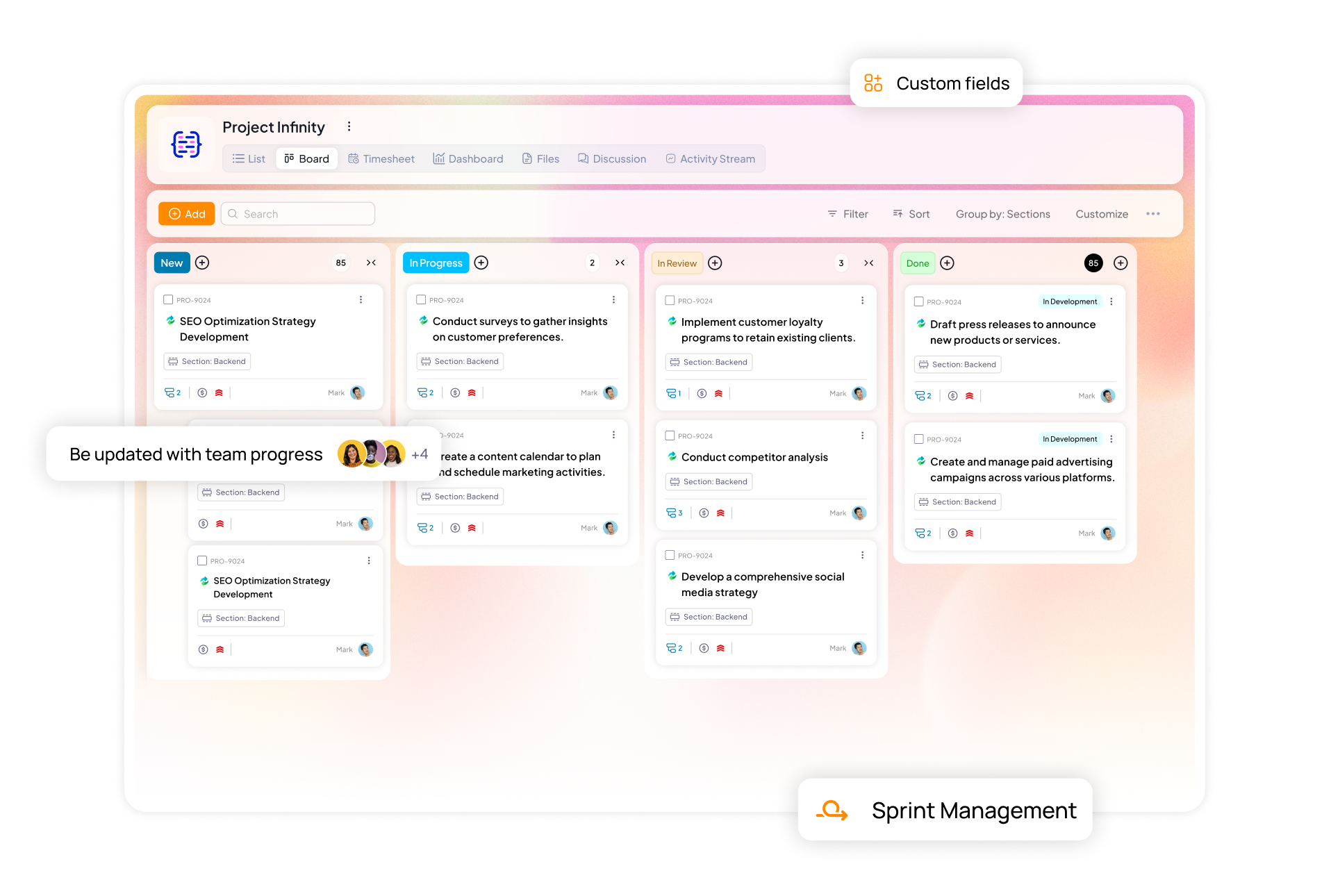On Monday, your team finalizes the campaign brief. By Thursday, the audience trends have shifted. By next week? Half the plan is already irrelevant.
Sounds familiar? That’s how marketing moves these days. It demands speed and clarity, and traditional processes just can’t keep up.
That’s where Agile marketing steps in.
Instead of rigid plans and reactive workflows, Agile marketing empowers your team to adapt and iterate. It helps you move forward with clarity. But agility needs the right support system.
If you’ve ever asked yourself what is agile marketing and how can project management software help, this guide has the answers (and a few expert tips, too).
What is Agile marketing?
Agile marketing is a responsive, iterative approach that puts the customer at the center of everything. It adapts as fast as they do.
Borrowing its foundation from Agile software development, this methodology emphasizes flexibility, cross-functional collaboration, and data-backed decisions, over rigid, long-winded campaign planning. Instead of locking into a 6-month plan and hoping for the best, Agile marketing teams work in short cycles (called sprints), learn from real-time feedback, and pivot fast.
Why does Agile marketing matter?
Because audiences change preferences overnight, platforms evolve weekly, waiting for quarterly reviews is no longer the norm.
Agile for marketing teams offers a better way to work with fewer silos and more experimentation. With Agile, marketers can deliver outcomes that align with what’s working.
What is Agile project management for marketing?
Agile project management for marketing is how teams bring Agile principles to life with structure, visibility, and speed.
Unlike traditional project management models (think waterfall or top-down timelines), Agile project management breaks down marketing initiatives into smaller, time-boxed sprints. These sprints focus on delivering real outcomes, like launching a new landing page or testing ad creatives, quickly and measurably.
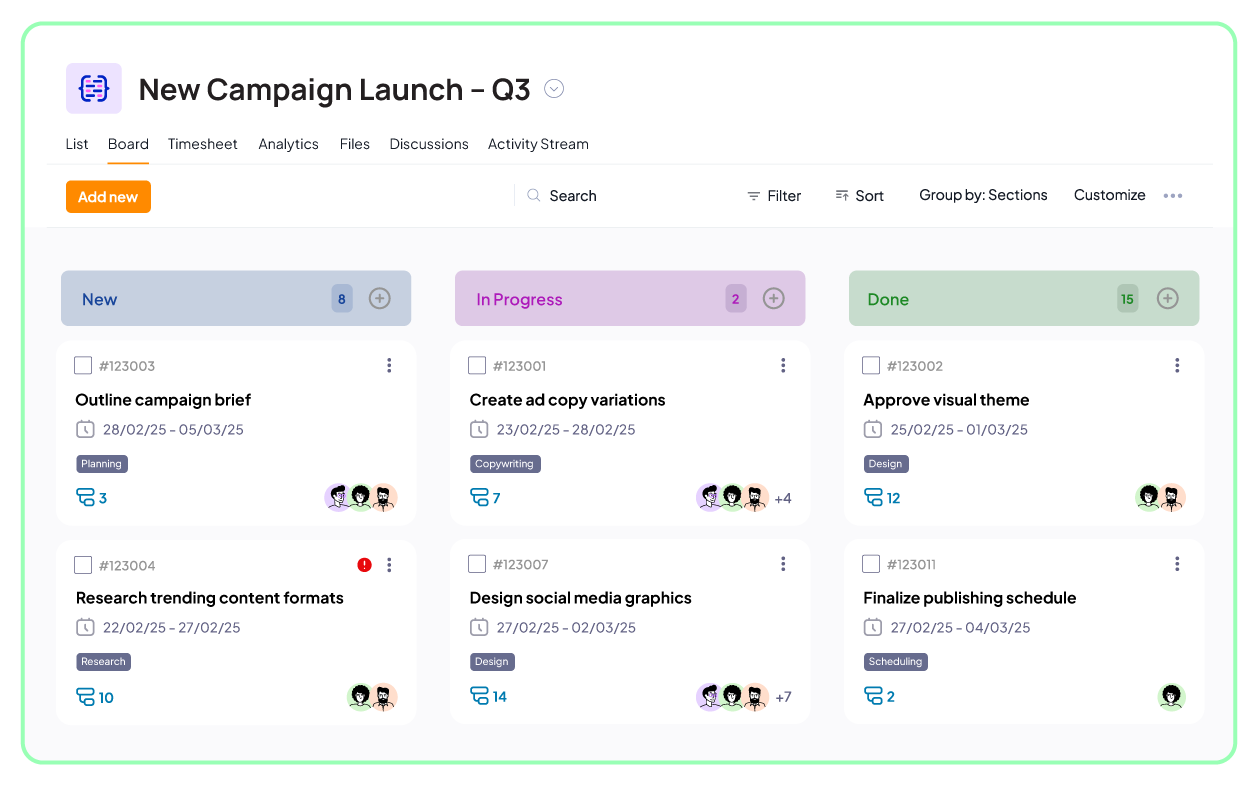
What does it look like in practice?
- Marketing tasks are reframed as user stories, which are specific and value-focused objectives like:
“As a first-time visitor to a website, I want to quickly find social proof and benefits, so I can decide whether to explore our product further”
- These stories are added to a backlog (like a campaign to-do list), then prioritized and scheduled based on business value and timing
- Work is delivered in 1–4 week sprints, followed by sprint reviews and retrospectives that focus on results and team improvements
- Teams hold daily standups to clear issues and keep momentum up
This structure helps avoid vague planning like “boost social media” and replace it with sharp, measurable goals tied to business impact (say, “increase Instagram CTR by 20% through carousel ad tests”). It’s also what makes the difference between a scattered team and one delivering results every sprint.
Why do marketers love it?
Agile marketing gives:
- More transparency, as everyone knows what’s happening, who owns it, and what success looks like.
- Faster feedback loops to help test campaigns and course-correct quickly
- Real collaboration among content creators, designers, managers and analysts all working in sync (and not in silos)
Agile project management transforms marketing from a guessing game into an insight-led engine that runs on experimentation and continuous improvement.
What are the four main principles of Agile marketing?
Customer-centricity over campaign-centricity
Stop guessing and start building campaigns based on real user behavior and feedback. For example, top B2B teams can run customer interviews or A/B tests before committing to full-scale content. This helps cut wasted effort and learn more quickly what resonates, then double down on high-impact variations.
Iteration over perfection
Launch minimum viable campaigns, gather data, and improve fast, without getting stuck in a revision loop. In marketing, week-old ad creative can already feel stale. That’s why leading brands release Minimum Viable Campaigns (MVCs), lightweight pilots that let you collect performance data within days, not months.
Cross-functional collaboration over departmental silos
Bring strategy, content, design, and analytics into one shared workspace to move faster and align better. Traditional silos slow you down and by the time your design team finishes assets, the strategy may already need updating.
Agile marketing teams working with copywriters, designers, data analysts, and channel specialists solve this by co-owning all sprint deliverables.
Data over intuition
Ground your creative bets in real-time signals, not just experience or “gut feels.”
While intuition has a role in sparking ideas, Agile marketing demands that you validate those ideas quickly with hard data. Having analytics tools in your sprint review allows you to change underperforming tactics before they swallow your budget.
In the words of Jim Lecinski:
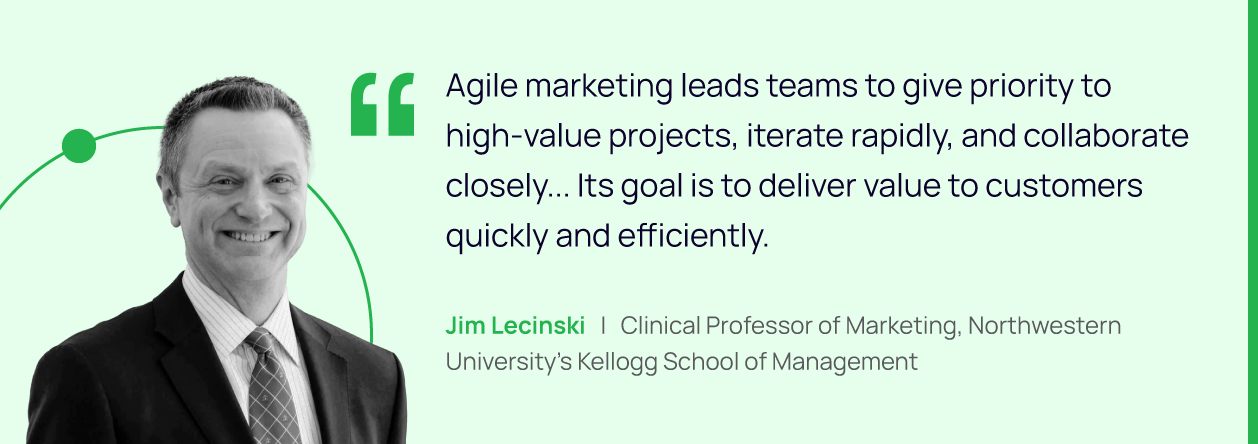
Why does traditional marketing struggle to tackle modern marketing demands?
The short answer to why traditional marketing struggles in today’s fast-paced environment is—because the old playbook wasn’t built for constant change.
Traditional marketing operates on quarterly plans and rigid approval cycles. But today’s consumers shift behaviors in weeks, not months. Campaigns often need real-time adjustments. And brands that wait miss the moment.
Here’s where things break down:
- Delayed feedback: Creative approvals that take weeks
- Siloed teams: Content, design, and social don’t collaborate
- Outdated tools: Spreadsheets, email threads, and never-ending Zoom calls
The result? Burnout and work that doesn’t align with business goals.
Benefits of Agile marketing in project management
Agile marketing improves workflows and transforms how teams think and deliver. Let’s look at some top benefits of Agile marketing in project management.
Better alignment with business goals
Marketing Agile project management teams regularly reflect on what’s working and shift their priorities. This means your team is always moving in the same direction as your company’s north star.
Faster execution and feedback
Short sprints in Agile marketing allow campaigns to deliver quickly. You test, learn, and iterate, instead of over-planning and under-delivering.
Increased transparency and accountability
When work is visible and broken down into manageable tasks, it’s easier to know who’s doing what and when. This leads to less micromanagement and more trust building.
Empowered, happier teams
Agile gives teams ownership. This way, project management for marketing teams becomes easier as they can choose what to work on, set realistic goals, and get breathing room to be creative.
How to implement Agile marketing?
Switching to Agile marketing methodology isn’t about copying top project management frameworks. It’s about building a mindset of adaptability.
Here’s how to implement Agile marketing for a great start:
Build cross-functional squads
Agile works best when teams are small, diverse, and collaborative. That means breaking down silos between content, design, performance, and strategy.
Each squad should be self-sufficient enough to deliver a complete piece of work, whether it’s a social campaign or a product launch. This helps reduce project dependencies and keeps the sprint moving without bottlenecks.
Pro tip: Use the “two-pizza rule”, keeping teams between 5–9 people to encourage focus and faster decision-making.
Set up short sprints with measurable goals
Work in 1- or 2-week cycles with a project plan for what’s achievable. Then, review performance, and adjust sprints swiftly. Every Agile sprint needs a purpose. This cycle of testing and adjusting keeps your campaigns relevant and your team focused on steady progress.
For example, “Increase lead-to-demo conversion rate by 15% through a new landing page A/B test this sprint.”
Specific goals help align your team, make it easier to prioritize tasks, and give your retrospectives something concrete to measure against.
Use Agile rituals
Agile rituals are simple, repeatable team habits that keep work focused and moving forward. These rituals help structure disorder in productive workflows. Start with:
- Daily standups (10–15 minutes): What did you do yesterday? What’s your plan today?
- Sprint planning: Set clear tasks, assign ownership, map out key dependencies, and define “done”
- Sprint reviews: Walk through what was delivered, discuss results
- Retrospectives: What worked? What didn’t? What can we do next time?
Checking these boxes will allow you to set up an engine of continuous improvement.
Track the right metrics
Agile thrives on feedback loops, but it’s important to shift from vanity metrics to actionable ones. Focus on these metrics:
- Sprint velocity: How much work is completed per sprint?
- Campaign ROI: Which initiatives are truly moving the needle?
- Customer engagement: Are users interacting the way you expected?
And always bring this data into your retrospectives to inform the next sprint.
Pilot before you scale
Don’t try to transform your entire marketing team in one go. Choose one team or project to run as a pilot.
Pick something with clear success metrics, a straightforward scope, and buy-in from everyone involved. Use this time to get comfortable with Agile rituals, tools, and workflows.
Then, learn from it and refine the process. Share those lessons across the organization before scaling.
Invest in the right tools
You need more than a to-do list. You need a visual, flexible system that supports iteration, collaboration, and feedback. Agile project management tools like 5day.io help you see progress at a glance, eliminate communication complexities and keep your Agile process on track.
Key features to look for in Agile marketing tools
Agile marketing needs more than basic task tracking, where you simply assign tasks and check them off a list. The right tools go beyond simple tasks like planning sprints and collaborate in rea time. Here are the key features to look for in Agile marketing tools:
Sprint management
The best project management software for marketing teams offers a sprint management feature that allows you to plan, monitor, and complete sprints. It helps your team without losing track of the bigger picture.
Multiple work item types
Not every marketing task moves through the same process. Look for tools that support different workflows for writing articles, designing ads, launching campaigns, assigning other assets, etc.
Use custom fields like word count targets for blog posts or budget inputs for ad sets. Create distinct statuses for each content type to contextually work on your tasks. For example, a blog post might move through stages, like “draft,” “in review,” “final edits,” or “approved.” On the other hand, a campaign might involve multiple tasks grouped into one sprint with dependencies.
Having custom work items ensures that your tools adapt to your team dynamics and not the other way around.
Visual boards
Drag-and-drop boards help you prioritize work and reduce confusion. Visual boards give your team a clear, shared view of what’s happening across every sprint.
You can also easily group tasks by sprint, assignee, campaign, or custom fields that suit your workflow. This helps your team stay aligned and move to the next process without confusion.
Collaborative workspaces
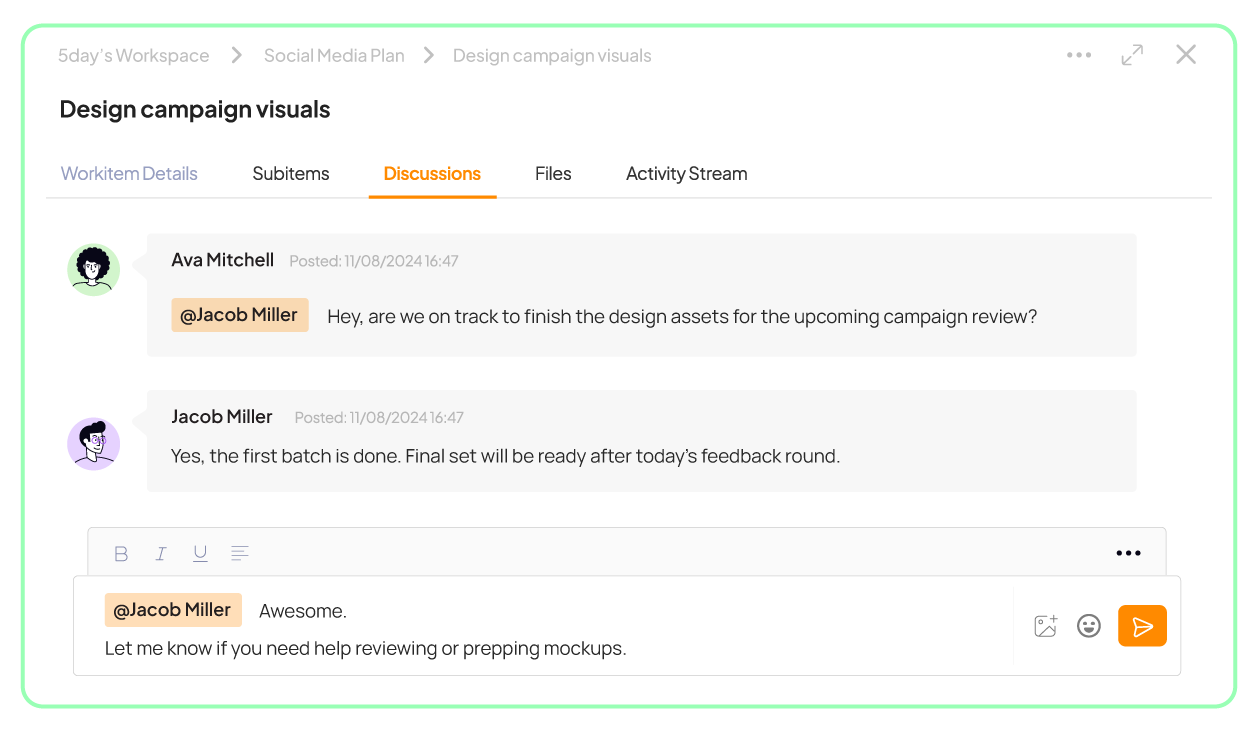 Teams need shared views and @mention tagging to work without friction. Create a single source of truth for briefs, files, creatives and updates. When every contributor can collaborate and see the same priorities and progress, teams move faster with fewer missteps.
Teams need shared views and @mention tagging to work without friction. Create a single source of truth for briefs, files, creatives and updates. When every contributor can collaborate and see the same priorities and progress, teams move faster with fewer missteps.
Time tracking & workload views
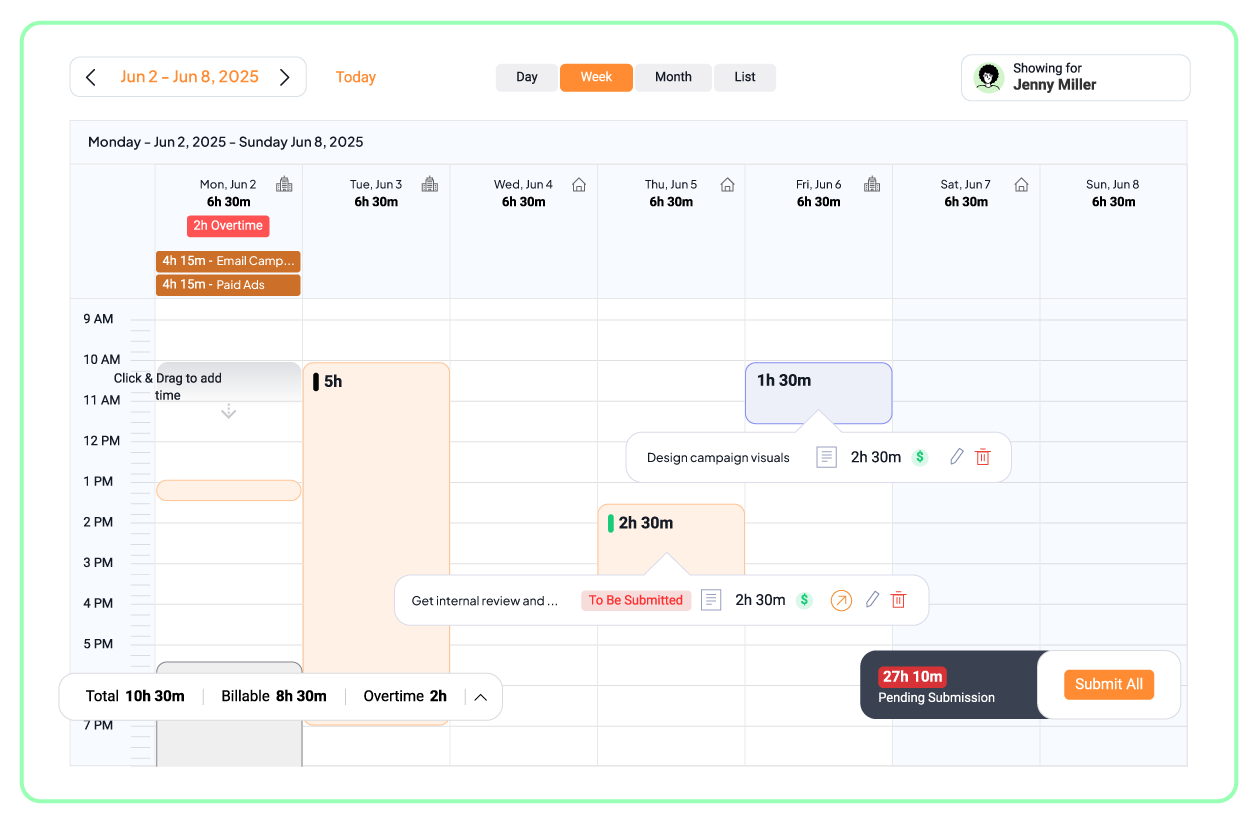
Feature-rich marketing project management tools for time tracking help avoid burnout and ensure balanced workloads. This further helps understand the actual effort behind the campaign and not just planned estimates.
For team leads, it’s a smarter way to plan upcoming sprints. For team members, it means setting better boundaries and avoiding the all-too-familiar “everything is urgent” feeling.
Built-in proofing and approving
This feature is useful when you need client or stakeholder signoffs. Chasing approvals via email threads or third-party tools only slows things down. Built-in proofing and approval features in your project management software help avoid version chaos by centralizing comments and revisions.
Custom views for different teams
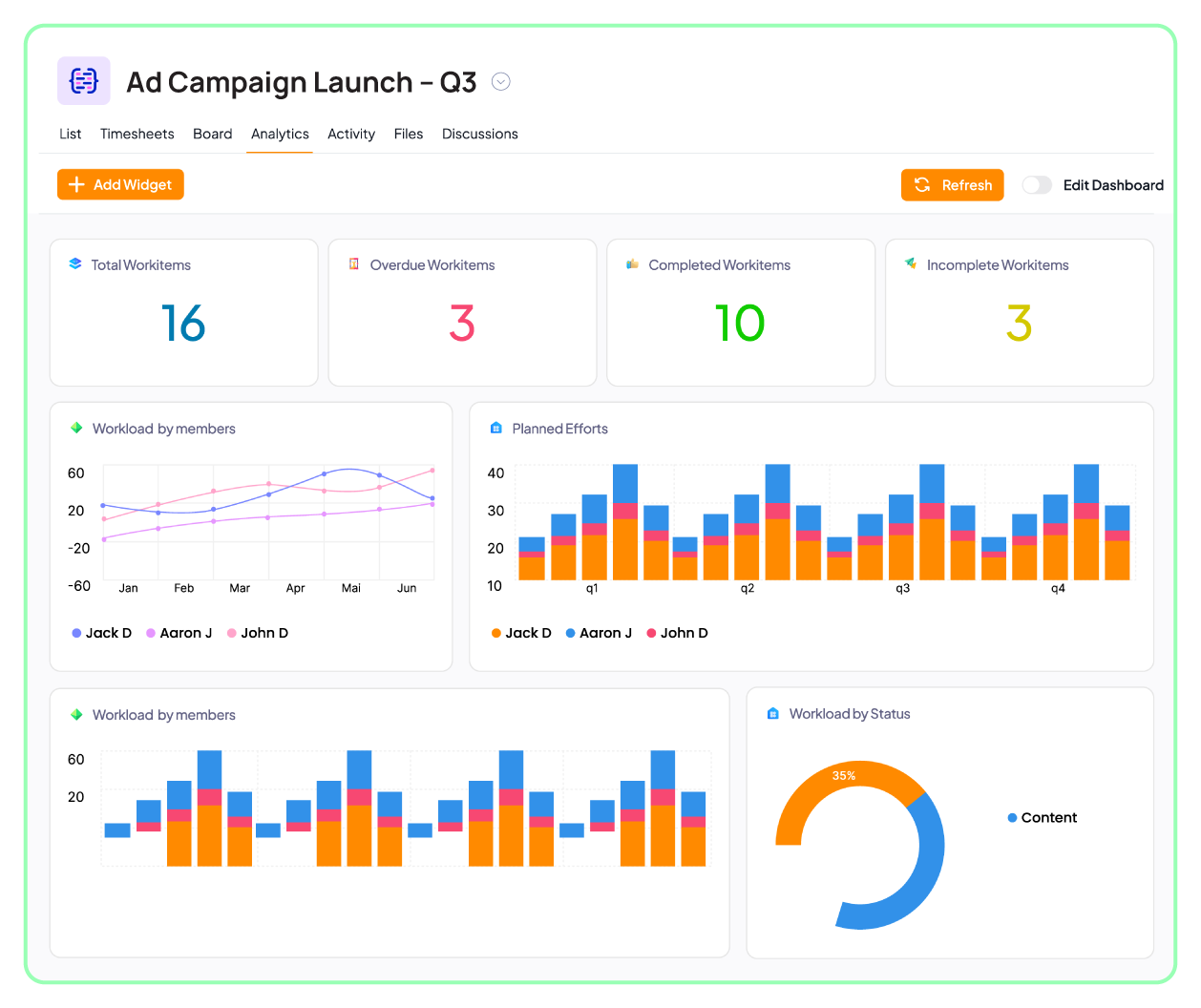 Let content teams see what matters to them, while design and strategy focus on theirs. This level of clarity helps every function stay aligned without being overwhelmed. It also encourages ownership, as teams have the power to manage their work in the way that suits their flow best.
Let content teams see what matters to them, while design and strategy focus on theirs. This level of clarity helps every function stay aligned without being overwhelmed. It also encourages ownership, as teams have the power to manage their work in the way that suits their flow best.
How 5day.io empowers Agile marketing teams?
Now you know what Agile marketing is and how project management software can help.
Agile marketing is best approach to shift focus from perfection to progress, from silos to shared ownership.
When done right, Agile helps your team stay responsive without losing direction. It empowers you to build campaigns around real customer signals and test them quickly.
But to make Agile work consistently, you need the right systems in place.
5day.io is a project management software for marketing built with Agile in mind because no two campaigns (or teams) are the same. Here’s how 5day.io empowers Agile marketing teams to stand out:
- Allows you to run sprint cycles effortlessly and track progress, so your team move with clarity
- From SEO blog posts to design deliverables, create custom fields and workflows for each asset type to match how your team works
- Discuss in context, upload visuals, tag teammates, and centralize feedback so you don’t need to hunt for updates in Slack
- View your marketing roadmap your way with Kanban boards and list views for daily tasks
- For quick approvals, you can invite external reviewers with limited access, helping you keep control while reducing the back-and-forth
- Understand how much time your team spends and where you can rebalance to spot burnouts before it happens
5day.io simplifies Agile marketing project management to help your team focus on launching better campaigns.
Ready to start building a marketing workflow that adapts and grows with your goals? Get started with 5day.io and run your next campaign the Agile way with zero chaos.
Frequently asked questions
How does Agile fit into modern marketing workflows?
Agile fits into modern marketing because it’s built for speed and iteration. It gives marketers a way to stay focused and respond to real-time changes.
Instead of locking in a plan for the quarter, you break work into smaller, more manageable sprints. With Agile, you test campaigns before committing big budgets. And most importantly, you adapt based on what’s working, not what was assumed to work two months ago.
If your team struggles with shifting priorities or campaign bottlenecks, Agile offers a practical, proven way forward.
Who typically adopts Agile tools in marketing teams?
Agile marketing tools are popular among:
- In-house marketing teams looking to move away from static workflows and gain better control over timelines, stakeholder feedback, and team capacity
- Agencies and creative studios managing multiple clients and creative approvals all at once
- Growth-stage startups and scaleups where go-to-market speed and marketing ROI need to improve quarter over quarter
But beyond “who,” the better question is why they use them. These tools track tasks, support sprint cycles, enable real-time team collaboration, and offer performance insights in one place. Tools like 5day.io project management software are built not just for task execution but for adaptive marketing management.
Why is Agile marketing a smart long-term strategy?
Because it helps your team stay focused on what matters, even when things change.
Agile marketing fixes project chaos and teaches teams how to work with uncertainty (not against it).
Instead of over-investing in campaigns that may not land, you test ideas earlier and learn faster. It helps you improve continuously. That shift in mindset pays off long-term:
- Helps waste less time on the wrong work
- Builds campaigns around customer signals, not gut feelings
- Gives your team room to collaborate without burning out
And when you do this, sprint after sprint? You build a team that’s adaptable and ready to grow sustainably. It works not just for this quarter, but for the next ten.






